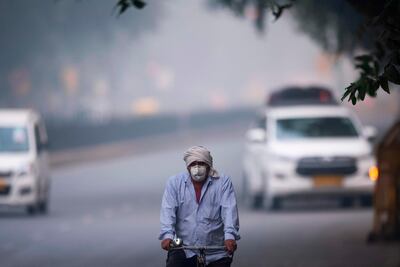Pollution-choked Delhi has been plunged into a state of emergency with dozens of flights cancelled, schools closed, asthma attacks on the rise and air quality dropping to its worst levels in three years.
Television footage of toxic smog enveloping the skies as fearful residents walk the streets in masks has shocked the world in recent days.
On Friday, a public health emergency was declared and Delhi’s chief minister Arvind Kejriwal said the city had turned into a “gas chamber”.
With conditions extreme even by the standards of one of the world’s most polluted cities, officials have advised the 46 million people living in greater Delhi to stay at home and to keep their windows closed, while authorities are restricting car use by banning on alternate days vehicles with registration plates ending in odd or even numbers until November 15.
The concentration of PM2.5, particulate matter less than 2.5 micrometres in size, rose to almost 900 microgrammes per cubic metre earlier this week, compared to the World Health Organisation’s recommended safe annual average of just 10 microgrammes per cubic metre.
Such fine particles - so small they are not visible to the naked eye - are emitted from a variety of sources, including cars and planes, power plants and agricultural burning.
They pose a particular danger as they hang in the air for longer due to being so light and are easily inhaled.
Professor William Bloss, of the University of Birmingham in the United Kingdom, has been looking at the sources of Delhi’s pollution through a research project, “An Integrated Study of Air Pollutant Sources in the Delhi National Capital Region.”
He said the city’s pollution problems “overwhelmingly” revolve around PM2.5s, contrasting with some western cities where nitrogen dioxide from vehicles ranks as highly as particulate matter as a concern.
“In Delhi, the really big sources are stubble burning outside the city region. The air has been affected by stubble burning blown into the city,” said Prof Bloss.
Local press reports citing satellite data suggest that there were as many as 3,000 farm fires in the neighbouring Indian states of Punjab and Haryana last week.
The fires rage at this time of year because farmers burn off stubble to allow a fast turnaround between crops.
State governments have faced stinging criticism for failing to clamp down on the practice, with India’s Supreme Court having accused them this week of “asking people to die”.
“It is too much. No one is safe even inside their house. It is atrocious,” judges said.
Pollution from within the city, such as traffic, contributes “to a lesser extent” to Delhi’s poor air quality, said Prof Bloss, although its effects are still significant.
Other sources within the city include solid-fuel burning by householders, and the burning of rubbish, which happens because waste disposal systems are inadequate.
The letting off of firecrackers to celebrate the Diwali festival, which ended last week, has also been blamed for the smog.

“We have to move to clean energy options, but there are an infinite number of small sources [of pollution],” said Professor Sachchida Tripathi, of the Indian Institute of Technology Kanpur.
Solid fuels should be replaced with liquefied petroleum gas, he said, while flue-gas desulphurisation should be deployed at power plants to reduce sulphur dioxide emissions, which are higher in India than anywhere else in the world.
To get people off the roads, experts say that public transport in Delhi must improve, especially as the city grows.
“The public transport is not reliable enough to transport people from one place to another. It’s a city which is growing. You cannot keep taking people in without putting in the proper infrastructure,” said Professor Prashant Kumar, from the University of Surrey in the United Kingdom, who is also involved in the Delhi air pollution research project.
Delhi’s air pollution woes are shared by many Indian cities, with a survey released earlier this year by the environmental group Greenpeace indicating that the country contains 22 of the world’s 30 most polluted cities. Delhi is the most polluted world capital and the 11th most polluted city overall.
In total, 99 percent of cities in south Asia reportedly exceed the World Health Organisation’s recommended limit for PM2.5, and all Middle Eastern and African cities analysed breach the limit.
Globally, as many as seven million people are thought to die each year because of the health effects of poor air, which include cancer, heart disease and respiratory conditions.
While India’s conurbations remain blighted by bad air quality, researchers are starting to see signs of improvement in some Chinese cities, even if many remain among the world’s most polluted urban areas.
“We’ve seen the air quality in Beijing improving. That demonstrates that informed regulation can have a positive impact said Prof Bloss, who has analysed air quality in Beijing as well as Delhi.
“It’s a problem we can solve. It’s not something we have to live with as the price of development.”










